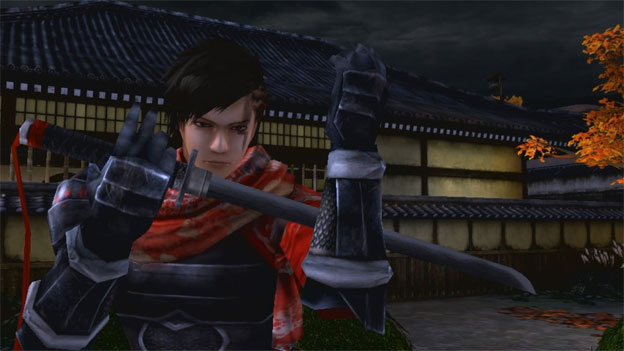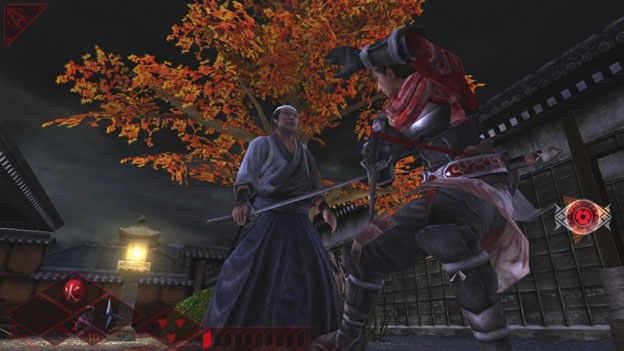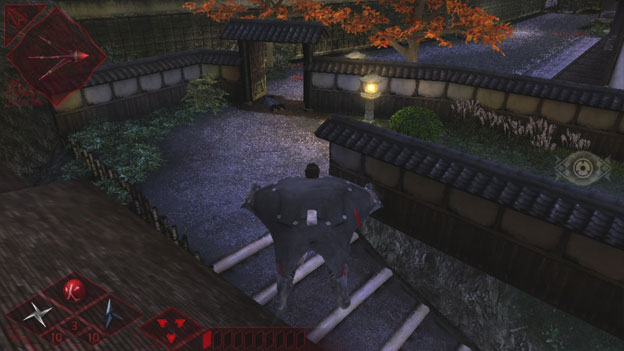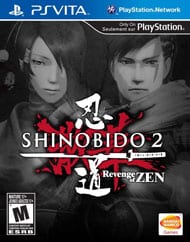Today’s Moment Of Zen
Back in the late nineties, while Metal Gear Solid was still waiting in the wings, Acquire put its own stealth-action game out the gate to a positive critical reception. Tenchu: Stealth Assassins was a ninja game that, rather than involving gratuitous action and high-flying acrobatics, was all about planning and misdirection. After a sequel in 2000, Tenchu 2: Birth of the Stealth Assassins, Acquire lost the Tenchu license to From Software (though they would come back in 2008 to make Tenchu: Shadow Assassins for the Wii and PSP). In the interim, Acquire decided to make a new stealth ninja series and so, in 2005, Shinobido was born.
The first game having never seen a North American release, Shinobido 2: Revenge of Zen is one of the Vita’s more esoteric launch titles. It’s also one of the least immediately appealing, with ugly graphics that would seem more at home in a PS2 launch title than upon the Vita’s impressive hardware. Character models are of simple construction, with jagged joints and stiff hair and clothes. Textures are nothing to write home about, but they aren’t offensive or extremely low resolution, providing a distinctive look for warriors in each of the major factions as well as the major characters. The game does animate well, maintaining a fast clip and making it possible to determine what an enemy is doing before he or she does it. This is important, since combat is as awkward as the game’s visuals.

As with the Tenchu games before it, Shinobido 2 strongly encourages the player to remain hidden and proceed with care. While the plethora of tools you can find, buy, and craft through alchemy are able to make direct combat easier, enemies typically have far more health than you, and your basic attack combo is both overly flashy and inaccurate, often missing on the third hit. If one must fight, this encourages defensive play, only poking out with an attack or two when an enemy leaves an opening. It’s far more effective to catch your foes unaware and finish them in a single strike. Sometimes, though, this isn’t an option, and the game forces a pitched battle. In these cases, the weakness of the combat engine fully shines through. Though one can upgrade one’s health, defense, and offense upon leveling up, these upgrades are extremely incremental, and take away from building up one’s grappling hook range and Zankoku meter.
The grappling hook was one of the original Tenchu’s greatest innovations, and it continues to pull its weight here. Rooftop traversal is absolutely key to this game, making the grappling hook an indispensible ally that, thankfully, controls wonderfully. While it can be aimed manually in a first-person mode (which one can control with the back touch panel instead of the stick, though I don’t recommend it), a quick tap of down on the D-pad will instead fire out the grappling hook in whatever direction Zen is facing, smartly aiming it at the nearest possible grapple point in that direction. Getting around is fluid and enjoyable, instead of plodding and arduous.

Zen, in general, moves quickly. Even when crouched, his progress is more than acceptable and, in a full-on sprint, he can leap from building to building with little issue. It’s a mite frustrating that he can’t change his facing on a dime, but this only occasionally becomes a problem, and requires only a small adjustment by the player. Items can be used easily with the D-pad, and thrown ones can be aimed through the aforementioned first-person mode. There are some other neat abilities gained over the course of the game as well, including the aforementioned Zankoku, which enables instant stealth kills from a safe distance, and Fukurou, a cloth that allows Zen to glide (controlled gyroscopically; no, you cannot disable or invert this). Whenever a new ability is introduced, the game provides a tutorial that can be practiced until the player feels comfortable with the technique.
Missions are offered by the three daimyo of Utakata, who are in a stalemate at the game’s inception. These run the gamut from the basic “kill a target” and “kill everyone” mission types to reconnaissance, item collection, item delivery, rescue, and kidnapping. Successful completion of these missions alters the military strength, income, and provisions of the three factions, as well as your relationship with each of them. These alterations not only affect the path of the game, but also the strength of each faction’s warriors in a level. If their faction lacks provisions, they will be weak and hungry. It’s an interesting system, though you’ll see the same (or extremely similar) missions a lot, since they’re just spit out by the mission generator. Also, while the game will tell you the base level of income you’ll receive, it doesn’t indicate how much experience a mission is worth.

Level variety, on the other hand, is an issue. While there are endless missions in Shinobido 2, they all take place in the same few types of locales. Yes, different enemies populate them and their layouts vary somewhat, but they all look similar to each other, which stymies the player’s sense of progress through the game. The primary measurements for that are Zen’s relationship with each of the three daimyo, their relative strength, and the sudden appearance of story missions in the mission queue. Story missions do not have to be tackled immediately, but the only reason you might really want to avoid advancing is to level up, make money, and construct equipment, to gird yourself for a possible boss fight.
Crafting, through alchemy, is an involved and intricate process. There are different jars you can buy that hold different numbers of ingredients (really, different effects, as two similar ingredients with different values still only take up one ingredient slot) and different overall volumes. Concoctions can be diluted to increase their volume and decrease potency or boiled for the opposite effect. Geckos (yes, the lizard) are able to transform or transmute, in different manners, the contents of a pot. Further, there are special combinations to be discovered, which add unexpected effects to your alchemical construct. Once satisfied with the ingredients in the pot, the player can extract them either as a smoke bomb, a potion, or sushi. There’s a Near element here, as well, with a network jar that can use devices detected through Near to alter the contents of the jar.

Regarding story—well, it’s there. The writing is not particularly engaging and the translation is, at times, unwieldy. However, it serves its purpose, and conveys the important events of the game reasonably well. The voice acting is passable and the sound is fairly satisfying. You’ll cringe when Zen walks near an enemy, each footstep so loud it seems it could bring your foes around at any moment, and the piercing of sword through flesh is appropriately aurally brutal.
Shinobido 2: Revenge of Zen is initially an intimidating endeavor. There is a lot to learn beyond just sneaking around in the shadows and claiming enemies in the darkness, but the game does a great job of easing a player into its systems, from the basic controls up through the advanced techniques, even in the alchemy and shop. Whenever you do something for the first time, a quick text tutorial pops up, which you may peruse at your leisure. These, once closed, are always available to be viewed again for clarification. In this way, Shinobido 2 becomes the kind of game that is not only good, but which a player wants to become good at playing.
RATING OUT OF 5 RATING DESCRIPTION 2.0 Graphics
Distinctly subpar. Though they don’t get in the way of the game, more is expected out of the Vita. 3.6 Control
Largely intuitive, the controls suffer only minor hiccups in close quarters. Also, it’d be nice to be able to modify the gliding controls. 3.2 Music / Sound FX / Voice Acting
Inoffensive, but hardly spectacular. Some of the sound effects stand out for their stark nature. 3.4 Play Value
This will depend a lot on how much you enjoy the core gameplay. There will always be missions to do, but they can certainly get repetitive, while main story missions are few and far between. 3.0 Overall Rating – Fair
Not an average. See Rating legend below for a final score breakdown.
| Review Rating Legend | |||
|---|---|---|---|
| 0.1 – 1.9 = Avoid | 2.5 – 2.9 = Average | 3.5 – 3.9 = Good | 4.5 – 4.9 = Must Buy |
| 2.0 – 2.4 = Poor | 3.0 – 3.4 = Fair | 4.0 – 4.4 = Great | 5.0 = The Best |
Game Features:
